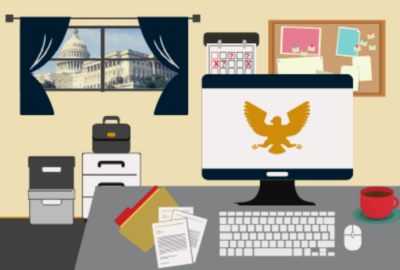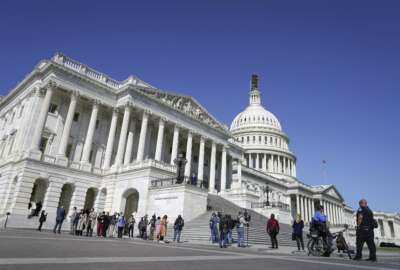Telework likely to accelerate plans to shrink federal government office space, study finds
The federal workforce’s use of telework, in the long term, could give agencies a unique opportunity to get rid of office space the government no longer needs.
Federal employees’ use of telework, in the long term, could give agencies a unique opportunity to get rid of office space they no longer need, according to a recent study.
The National Capital Planning Commission, in partnership with the Metropolitan Washington Council of Governments (COG), released a study in February looking at the federal workforce’s use of telework and its impact on government office space.
The study finds that federal telework will “likely accelerate the implementation of reducing the federal footprint,” but may also shake up the local economy of Washington, D.C. and the surrounding area.
“Any changes in federal telework policy will have a significant impact on Washington, given that it has a large component of telework-eligible jobs,” the study states.
Only about 15% of the federal workforce works in the national capital region, but the federal government is still the region’s largest single employer and its largest owner of real estate.
The General Services Administration holds about 47 million square feet of owned space and 44 million square feet of leased space in the national capital region. That translates into about 190 federally owned buildings and 500 federally leased buildings.
Meanwhile, the 400,000 federal employees working in the D.C. metro area make up about 11% of the region’s total workforce.
NCPC Senior Urban Planner Angela Dupont said in a recent interview that more teleworking federal employees may give agencies a chance to shed underutilized office space.
“Before the pandemic, we already acknowledged that there were a lot of federal buildings that were underutilized. Federal telework just helps us accelerate the opportunities to either use our space better when federal agencies may be consolidating in the future,” Dupont said.
The study looks at several scenarios. On the low end, it studies a “minimum,” pre-pandemic level of telework from federal employees — about one or two days each two-week pay period.
The study also considers the impact of a “moderate” (four to six days per pay period) and “maximum” (eight to 10 days per pay period) level of federal telework.
“As you get to more telework, there is probably a greater ability to reduce a lot of this federal office space, because the demand for a federal office may not be as great, when you have more federal workers teleworking,” Dupont said.
Federal telework’s impact on the region, however, may vary across D.C., Virginia and Maryland.
Stan Wall, managing partner of the D.C. office of HR&A Advisors, Inc., which conducted the study, said a concentration of mostly in-person defense and national security jobs in Virginia will likely result in minimal impact on the local economy.
“If you are a Northern Virginia jurisdiction, and you know that your county or your city has a number of defense facilities, fairly few administrative, you can probably be fairly comfortable that your return to work is going to look a lot like pre-pandemic,” Wall said.
The same goes for Maryland, because of a higher concentration of federal research and laboratory facilities — such as the National Institutes of Health.
The study, however, finds any lasting changes in federal telework policy will have a significant impact on Washington, “given that it has a large component of telework-eligible jobs,” and accounts for nearly half of the leased federal office space in the region.
More than half of GSA’s leases are set to expire by 2027.
While agencies are selling workplace flexibility as a perk to new hires, Wall said it’s also allowed federal employees to be more dispersed.
“Rather than want to live near transit, live close to the core of the city, people might be moving out further into the suburban areas, rural areas, where they can afford housing,” Wall said.
The Biden administration since last fall has been urging federal employees in the D.C. area to return to the office more often. Meanwhile, D.C. Mayor Muriel Bowser is looking to revitalize downtown , in the hopes of drawing more business to the area.
Wall said the federal and local governments can also take less coercive steps to get government workers to work in the office more often.
“It’s not just a policy of get back in the office, it’s how do we create that environment where you actually want to be there in the office,” Wall said. “Even if it might be required to be there two days a week, I might want to be in the office four days a week, because I really have these great restaurants, great parks, great other amenities that helped me want to be in the office,” Wall said.
Copyright © 2025 Federal News Network. All rights reserved. This website is not intended for users located within the European Economic Area.
Jory Heckman is a reporter at Federal News Network covering U.S. Postal Service, IRS, big data and technology issues.
Follow @jheckmanWFED






